INBOX INSIGHTS: The Unaware Audience, Micro-Forecasting, Recommendation Engines (5/18) :: View in browser
Register for our free LIVE webinar, Customer Care Through the Customer Journey on May 24 »
Finding the Symptoms
A few weeks ago I was thinking about the unaware audience. How to help people realize that there was a problem and that you had a solution that would help. At that time, I was thinking about educational content that would support your solutions. It’s a good tactic, but it’s not the whole story. How do you know what content to publish?
Since then I’ve been digging deeper. How do you help the unaware audience connect the dots to become aware of a problem? You layout the symptoms.
Ok, taking a step back, how do you, the marketer, find the different symptoms and connect them to the audience, so you can connect them to the solution?
Natural Language Processing for Product Development
You might be collecting customer feedback, such as support calls or tickets. All this data, when processed, can give you cues about what you might be missing. Using natural language processing can help you understand the frequency of specific terms that will mean something to you. For example, we worked with a client that had millions of records of customer support data. So much so, that they were struggling to get ahead of product development requests. We applied natural language processing to their data and helped them learn the different symptoms their customers had. The customers wanted a new kind of non-dairy milk that accounted for nut allergies. Without processing all that data and finding the trends within it, the company would have fallen behind and not delivered a solution. They needed to find the symptoms of emerging problems to create solutions.
You can read the full case study here »
Natural Language Processing for Hiring
Are you finding the right candidates? Like your customers, your potential employees have needs that you may not be meeting. When you’re trying to hire, you may have a mismatch between what you think your employees want and what you’re actually offering. If you’re not processing the candidate feedback, you may have job postings that fall into the void. We had a client that ran into this exact issue. They were not attracting the right kind of candidate and couldn’t figure out why. We used natural language processing on their data to learn that there was a mismatch between the benefits they were listing and the questions candidates had. They needed to find the symptoms of the job applicants so that they could meet their needs with the benefits offered.
You can read the full case study here »
Social Listening as Part of the Customer Journey
You may not have mountains of unstructured data waiting for analysis. What your audience wants is still something you find out using social media. This is where social listening can help you. Tools such as Talkwalker or Sprout Social have natural language processing built-in that can summarize conversations and be on the lookout for specific keywords. Using these tools will allow you to learn what problems they are experiencing. You need to understand the symptoms at every stage of the customer journey so that you’re meeting your audience where they are.
If you want to explore this topic more you can join me and my good friend Brooke Sellas on May 24th at 12pm EST for Customer Experience through the Customer Journey – an exclusive live webinar.
Once you know the symptoms, and what your audience wants, you can deliver on your content and solutions.
How do you listen to your audience? Tell me in me in our free Slack Group, Analytics for Marketers »
– Katie Robbert, CEO

Do you have a colleague or friend who needs this newsletter? Send them this link to help them get their own copy:
https://www.trustinsights.ai/newsletter

In this week’s In-Ear Insights, Katie and Chris discuss recommendation engines. These seemingly straightforward pieces of technology control enormous aspects of our daily lives, from what we buy to what news we’re exposed to. How should your marketing strategy incorporate recommendation engines, and how do you know when recommendation engines are at work? Tune in to find out!
Watch/listen to this episode of In-Ear Insights here »
Last week on So What? The Marketing Analytics and Insights Live show, we looked at how ready your organization or department is to adopt artificial intelligence. Learn our scoring model on this week’s show! Catch the replay here »
This Thursday at 1 PM Eastern, we’ll be looking at durable and non-durable trends. How do you determine whether you can accurately forecast something? Are you following our YouTube channel? If not, click/tap here to follow us!
Need a reminder? Click here for a calendar appointment:

Here’s some of our content from recent days that you might have missed. If you read something and enjoy it, please share it with a friend or colleague!

Take your skills to the next level with our premium courses.

Get skilled up with an assortment of our free, on-demand classes.

In this week’s Data Diaries, we dig into predictive forecasting of a different nature: very short-term forecasting, or micro-forecasting. Most of the time, we use predictive analytics to forecast ahead by weeks or even months. But for some businesses, micro-forecasts down to the hour may be helpful in ways that larger forecasts are not.
Let’s take a look at an example. Suppose you’re a local restaurant. You send out email marketing and maybe even text messaging marketing on a regular basis to your customers. When would be the best time to reach them?
Conventional wisdom might say to reach out at or near mealtime, at supper time. And that’s not necessarily incorrect; anyone who’s ever had a conversation with a partner, friend, or roommate has inevitably had the “what do you want for dinner” debate, often with an impulsive choice at the end.
But when it comes to marketing and demand, the earlier we can intercept demand while still being relevant, the better. Demand interception is the companion to demand generation; instead of trying to stimulate demand for a product or service that our audience may or may not want, it’s easier to intercept the audience’s demand. To our audience, it almost feels like magic when we get it right: “Somehow you knew exactly what I was thinking just as I thought about it.”
To identify that kind of demand, one of the best resources to use is search data. People will search for something online long before discussing it with someone else. Suppose we took a simple search query like “dinner ideas”. What would it look like if we charted out this very popular musing? Using the free Google Trends software, we initially start here:
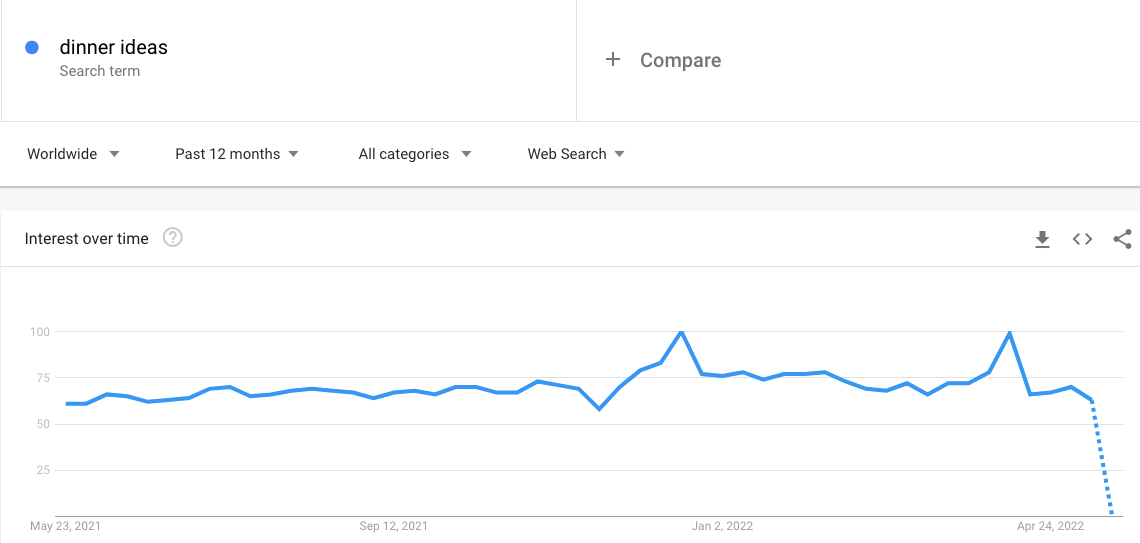
At this scale, there isn’t much usefulness here. Let’s zoom down to one locality – Massachusetts in the USA (where Trust Insights is headquartered), and one week’s time:
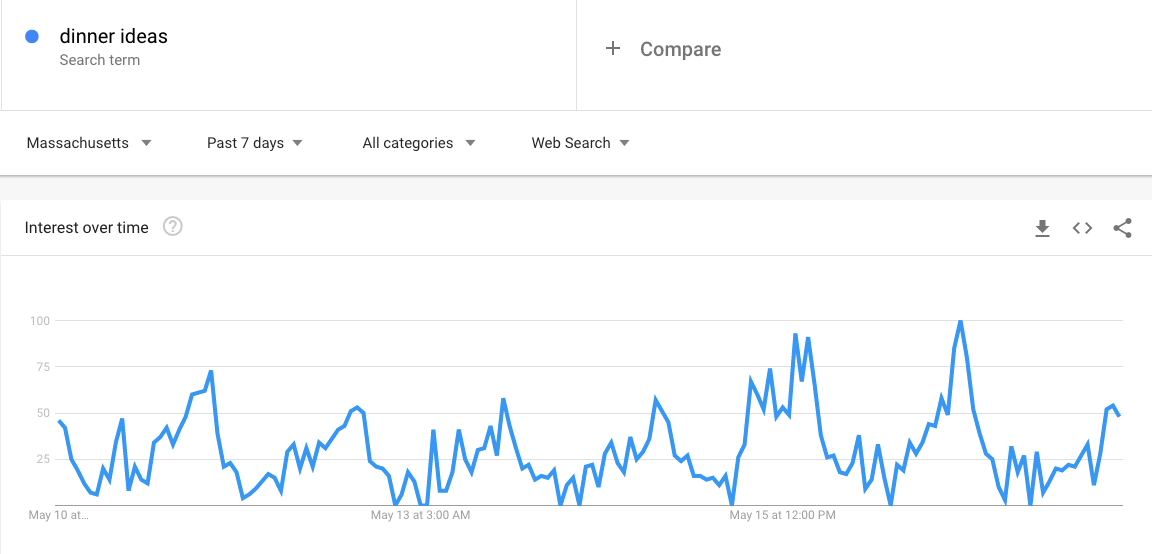
Now we’re talking. We can see data at the hourly level rather than at the weekly level in the broad forecast. What we also see is very strong cyclicality – a clear rhythm like a heartbeat in the data. When you see cyclicality, it means you have the ability to predict with accuracy. Let’s summarize it by hour:
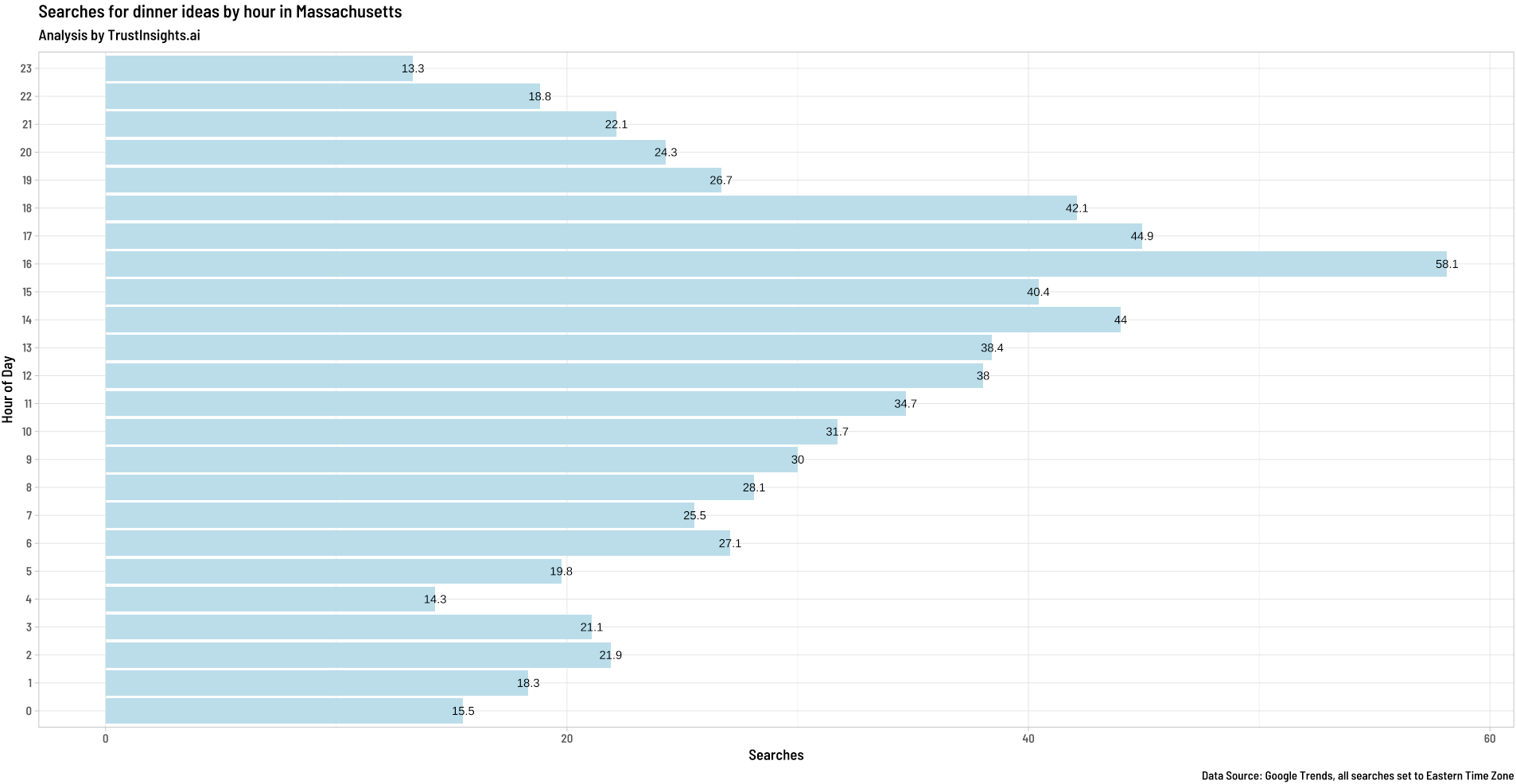
We see that the peak time for searches in Massachusetts for dinner ideas is 4 PM Eastern Time, but we also see that the searches begin as early as first thing in the morning. There’s a substantial bump around 11 AM. So, knowing this, what’s next?
Our next logical step would be to create a forecast. Using the modeltime package in the R programming language, let’s forecast forward for the next 7 days when searches for “dinner ideas” would occur in Massachusetts:
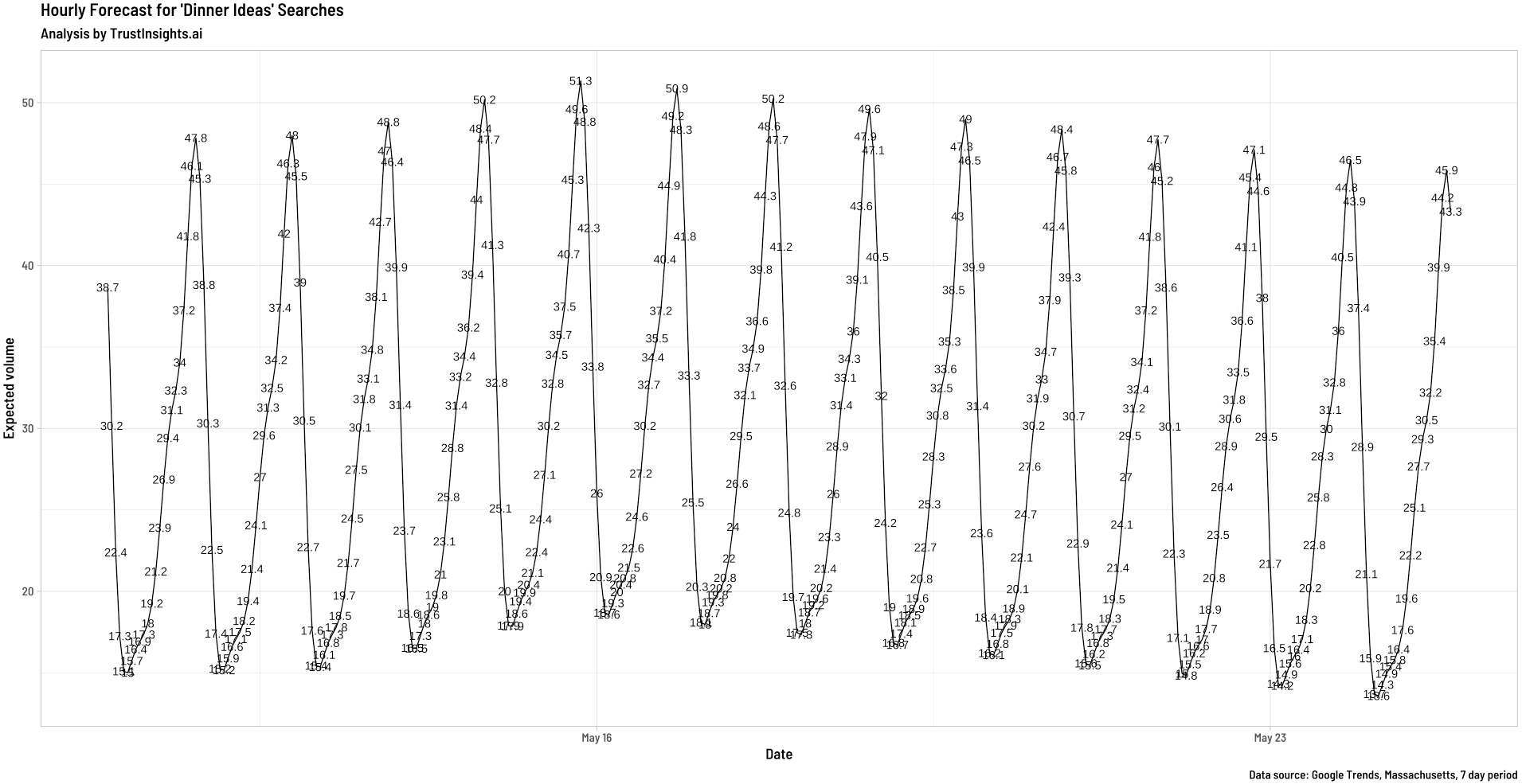
We see the same kind of cyclicality here that we saw in the trend data; so far, so good. The forecast doesn’t look like some crazy distorted model that in no way reflects the reality of the data fed into it – a real problem with some kinds of forecasts. Always reality-check a forecast before using it.
What does the forecast say for the coming week?
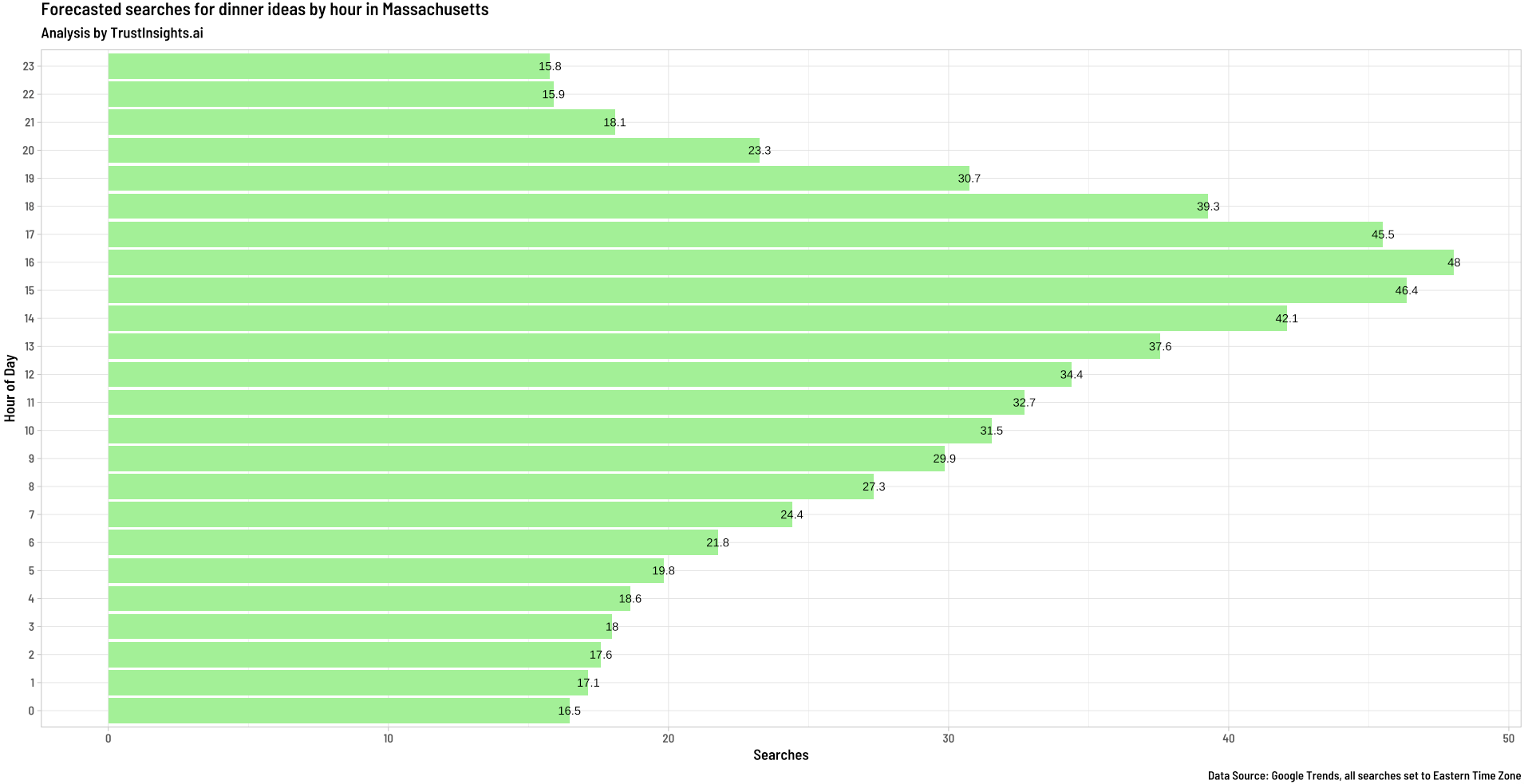
We see the inflection towards peak volume right around 1 PM, with a maximum value at 4 PM. If you wanted to capture demand, what would you do with this information? If I had the usual array of marketing channels available, I’d send out an email around 11 AM, knowing that it takes people a little while to check their email, and I’d get text messages to customers around 2 PM, just an hour before the golden demand peak from 3-5 PM.
Remember that we don’t want to try capturing the demand at the time it happens – we want to be just ahead of it so that we have share of mind when our audience starts thinking about the problem, but not so far ahead that we seem irrelevant. At the start of this newsletter, Katie mentioned the unaware audience, the audience that was unaware of the problem. Someone searching for dinner ideas isn’t that audience – they’re aware of the problem and starting to look for generic solutions. That’s the time for demand interception.
Micro-forecasting is one of the techniques we can use for demand interception – by being in the right place at the right time, just before our audience really starts thinking about the solution to their problem, we can jump the line of potential solutions. If your business or industry is well-suited to micro-forecasting, give the technique a try.
Disclosures and Methodology: Trust Insights extracted hourly data from Google Trends for the term “dinner ideas” in the US-Massachusetts geography. The timeframe of the data is May 1-May 17, 2022. The date of study is May 18, 2022. Trust Insights is the sole sponsor of the study and neither gave nor received compensation for data used, beyond applicable service fees to software vendors, and declares no competing interests.


This is a roundup of the best content you and others have written and shared in the last week.
Content Marketing
Data Science and AI

Are you a member of our free Slack group, Analytics for Marketers? Join 2300+ like-minded marketers who care about data and measuring their success. Membership is free – join today. Members also receive sneak peeks of upcoming data, credible third-party studies we find and like, and much more. Join today!

Customer care. The term conjures up the mental image of a bored employee answering calls in a call center, but the reality is that customer care is a core part of customer experience and goes far beyond traditional customer service. In this free live webinar on May 24 from Trust Insights and B Squared Media, learn:
- What modern customer journeys look like
- Where customer care fits into each stage of the customer journey for maximum impact
- How to leverage social listening in the customer journey
- How to identify content appropriate for each stage of the customer journey
Click/tap here to register for free today »
Interested in sponsoring INBOX INSIGHTS? Contact us for sponsorship options to reach over 22,000 analytically-minded marketers and business professionals every week.

Where can you find Trust Insights face-to-face?
- Customer Care Through the Customer Journey, May 2022, online
- Spark.me Conference, June 2022, Montenegro
- MarTech Conference, June 2022, virtual
- MAICON, August 2022, Cleveland, OH – use code PENN150 for $150 off any conference ticket
- Content Marketing World, September 2022, Cleveland
- MarketingProfs B2B Forum, October 2022, Boston
Going to a conference we should know about? Reach out!
Want some private training at your company? Ask us!

First and most obvious – if you want to talk to us about something specific, especially something we can help with, hit up our contact form.
Where do you spend your time online? Chances are, we’re there too, and would enjoy sharing with you. Here’s where we are – see you there?

Our Featured Partners are companies we work with and promote because we love their stuff. If you’ve ever wondered how we do what we do behind the scenes, chances are we use the tools and skills of one of our partners to do it.
Read our disclosures statement for more details, but we’re also compensated by our partners if you buy something through us.

Some events and partners have purchased sponsorships in this newsletter and as a result, Trust Insights receives financial compensation for promoting them. Read our full disclosures statement on our website.

Thanks for subscribing and supporting us. Let us know if you want to see something different or have any feedback for us!
|
Need help with your marketing data and analytics? |
You might also enjoy: |
|
Get unique data, analysis, and perspectives on analytics, insights, machine learning, marketing, and AI in the weekly Trust Insights newsletter, Data in the Headlights. Subscribe now for free; new issues every Wednesday! |
Want to learn more about data, analytics, and insights? Subscribe to In-Ear Insights, the Trust Insights podcast, with new 10-minute or less episodes every week. |
